|
Posted by Romy the Cat on
09-03-2008
|
|
Here are a number of threads at my site where the concept of “Rightsizing from extreme systems....” is pitched. I looked into the “second” systems not because I was interested in “different sound”. In fact I insist that multiple playbacks in the same listening room is in away a declaration of system owner’s Moronity. My interest in second playback is purely utilitarian. Macondo and Melquiades do well but they big, hot, and demanding. The amp need to be warmed up and so on… it is always nice to have a small scale SS driver playback that instantly or always, that is cool running and not too finicky. From a different perceive, I would like to use the sores that I have – so the none-fastidious second playback much be driven from the same preamp as the rest of my system. For instance: I run my Rohde & Schwarz Tuner all time - 24/7, and listing current and upcoming programming sometimes I would like turn the big Macondo on and sometimes I have no needs on interest…
Back to my Photography live we used studio flashes with pilot lights. The pilot lights were connected to the same dividers as the strop bulbs, use the same reflectors and if the flashes were made by serious companies then the pilot lights also very accurately to model and predict the character of the lightning that the given set of the lights would produce when the flashes go off. In fact in some case I preferred to shot just with pilot lights if I need a long exposure and was able to handle the color temperature… but it would be a separate subject…
So, looking at the way how I us my playback I wonder: why our large and extended installations might not include options for Pilot sound souses. If we presume that our main systems are installed at the best locations in our rooms then why do not incorporate into our mains systems the provisions for a small and perhaps crapy “summer monitors”? For instance is I design the Macondo Frame not I would incorporate into the frame a provision for building in a few direct radiators drivers. Let say a pair of 5” ported midbass drivers in MTM configuration, where the MTM’s tweeter sits right behind the Macondo’s Water Drop. I am not planning to do any change to Macondo but conceptually I think it is very interesting and beneficial idea – to have a good and bid system with imbedded option to do run it with “less blood”. In the case of 12 channels multi-amped Macondo it is particularly a blessing… Since I am a first to my knowledge who propose this concept I would like to name the notion and MiniMe systems (courtesy to Austin Powers movies)
Interesting that the MiniMe sections of big systems should not necessary to be a crapy sounding systems. With knows dose of creativity, talent and skills the MiniMe systems might be good. It is like design of motorcycles engine – the specific limitations of the motorcycle architecture forces the engineers to implement in motorcycle engine some decisions that would make big cars to envy…
I certainly do not try to propose that the MiniMe sections need to match or mimic the sound character of big system the MiniMe is implanted into. But it might be good enough to let a person do not have any another speaker in his/her room and would make the use of the main installation much more accommodatable for ordinary and non-demanding (did I say non-air-conditioned) listening. Rgs, Romy the caT
|
|
|
|
Posted by DHT4ME on
09-03-2008
|
We now call those modeling lamps in our big stobes. I think that the analogy is even better considering your intentions.
I personally feel strongly that high sensitivity is the correct path and that small ported woofers in a MTM box will fall short of the goal of reality in a smaller package. They certainly will get the upper frequency and dynamics ok but from experience will fall short in the lower mids and upper bass ranges. Now a line array of say PHL 1120's with a proper ribbon could be another story.
Possibly I am not on the right track with where you want to go as it seems like you want this section to be able to pop in place of the corresponding section of your large system.
Bob
www.PlateauLight.com
|
|
|
|
Posted by Romy the Cat on
09-03-2008
|
|
Bob,
Yes, the variants are multiple but the key I feel might be the following: smaller size, less reliance to baffled, smaller size. Or yes, did I mention the smaller size?
The thing that led me to think about the MiniMe incorporation was my recent discovery of 4” driver that in practically no enclosure (1/8 cu. ft.) does very nice “full-range” sound and being combined with a regular tweeter it does remarkably good. Well, I would not call it “remarkably good” in absolute since but it does reputable sound, much better than most of high end speakers (I am not kidding) and the driver cost $11 (I am not divulging at this point what it is). So, playing this driver in 6” tall speaker and loving the result I was wondering why I can’t stick the drive and the tweeter in my Macondo frame – it need practically no enclosure… BTW, it is interesting that you mention the “PHL 1120's with a proper ribbon”. I did ordered 2 days ago a “proper ribbon” for my none-integrated all-time-on MiniMe system. So, might be I will be using something similar to what you proposed. I just would like to drive it into a smaller package possible but I also need it to tolerate a lot of volume abuse.
The point is that I very much like idea to have solid state A/B cool rums amp that drive the MiniMe installation that is completely integrated with Macondo. Then, if I wish, I can only by flipping one switch to I can defeat the MiniMe system and turn the big system on. It is what I have no but my monitors are free-standing and not incorporated with Macondo. If I design the Macondo not from scratch then I would put somehow the MiniMe provision in the Macondo’s Frame.
The Cat
PS: BTW, the MiniMe option is not the 7th channel that I was promising last week.
|
|
|
|
Posted by DHT4ME on
09-03-2008
|
Gosh
I would have thought that those tube space heaters would be welcome in that frigid Boston climate.
It was 107 here 2 weeks ago. I leave most of my system on 24-7, you should have seen my August electric bill.
FWIW I rarely have to use the heater in the winter months and my art gallery has never had to use the heat.
Bob
www.PlateauLight.com
|
|
|
|
Posted by Paul S on
09-03-2008
|
|
Many years back, when I first went to try using more than one set of speakers in the same room, I was told that the "idle" drivers would have a negative aural effect on the drivers being listened to. Naturally, I went ahead and did it anyway. And the guy was right; it did suck power at different frequencies, almost like phase cancellation.
Is this a "who cares" situation, or might this matter, if it also proves true in your case?
Best regards,
Paul S
|
|
|
|
Posted by Romy the Cat on
09-14-2008
|
Ok, at this point the design idea about the Macondo’s Pilot sections are formed in my head. It will be two way MMTMM or MMMTMM configuration with extremely low footprint that would be perfectly integrated (as add-in) and “hidden” into the Macondo’s frame. Most like it will be steel-made ported enclosure and it will be a fool-range, foe to 25Hz I presume. I do have a clear idea about the drivers how it all will work out. What I am not convinced is the design of the port. I know all formulation how the box and the port shell be arranged but I personally never build anything with ports and have no idea how all those theoretical prediction relate to sound. So, what I would like to do something simile to how the variable-sweep wing done in aircraft (geometry of winds changes depending or speed and altitude) where port opening will depend of the specific position of the speaker in the boundaries of my room. Is anybody having pointers how it has been done before? I have a dozen visions how I might do it but I think it is shell be out there some kind of proven off the shelf solution.
The Cat
|
|
|
|
Posted by DHT4ME on
09-14-2008
|
The first thing that comes to mind is what is the range that the drivers will cover and what is the Fs of the drivers.
Another thing to consider is the loading type on the bass units you have.
I take it that they are sealed ? If so I would not consider a reflex for the mini.
|
|
|
|
Posted by Romy the Cat on
09-14-2008
|
|
The bass units meant for ported loading of cause, I might measure the Fs later on but I am not sure that I would need it. I don’t have any of T/S characteristics for my bass drivers. The driver behave as I needed them in prototype version and it is all that count. I think Thiel speakers in past had adjustable profile of port… I need to educate myself about those damn ports, particularly how the point of port entry affects the sound in case if the drivers are spread… Also, I would be interested not know how substitute of one post with 2-3 small ports play in the picture…
The Cat
|
|
|
|
Posted by Paul S on
09-14-2008
|
The Thiels I have heard "load up" considerably as the cabinet is pressurized. I suppose this is a strategy, but I will say again that I think the best results are when the driver is not pushed to Fs, and certainly the tuning should be well above Fs, IMO. I think that if you guess right you should not get changing pitch or a tightening of the sound, nor "chuffing", up or down the range. You might get small ports to work, but you might well fare better calculating a volume that allows somethig like 15% or so of the driver area and a port length that does not exceed 1/2 the depth of the cabinet. IMO the port itself should be strong/damped, or cardboard, but not bare metal or bare plastic. Maybe start with a mule; it's a lot less trouble than tuning/turning horns, but as with horns the math model will only get ypu in the ballpark (if you are lucky). About anything in the port can change the sound, just like adding a little clay in a horn throat. Laugh, but the "golden ratio" thing seems to +/- work for height, width, depth relationship of cabinet inside measurements. Felt to taste.
Best regards,
Paul S
|
|
|
|
Posted by DHT4ME on
09-14-2008
|
Honestly there is not enough info here to make a usefull recommendation. If the drivers are going to be used from the 95hz crossover point up then you might not even have to worry about it if the Fs is well below that. I would not do it anyway since acoustic suspension/ sealed bass does not integrate with a ported mid well.
It has to do with the way loudness builds. In this case a well damped sealed or variovented box is the best bet.
|
|
|
|
Posted by Romy the Cat on
09-15-2008
|
|
Well, the license of think this way was given to me by one mini-monitor that I found to sound “promising” for the objectives that I would like to achieve. In fact not even the monitor itself but the bass driver, the drive that in a way was unique characteristics. When I said unique I did not mean exceptional but rather no common – I would not at this point to comment about the driver’s quality of sound. So, I figured that 4-8 of those drivers combined with “slowed” ribbon will do for me.
I don’t think that this is a conversation about my desire to me a ported speaker to sound better – it is not my objective and you would hardly find a more jaded opponent of port enclosure then me. Bu any tool and any solution is applicable only within a scope of a given requirements and the requirement for my Macondo MiniMe is very simple: to get more or less OK sound with smallest footprint possible and capable to care high power, let was 100W.
So, I have to prototype and it looks like it might work with those drivers that I found. Hey it even sounds very nice, or put in this way – promising. Since it will be a tall enclosure (magnetically attached to the Macondo’s frame) I wonder where to locate the posts. In the image below depicts the question: shell it be red, green or yellow approach. I also have no clue how deep shell be the point of port’s end into the enclosure, among many other things…
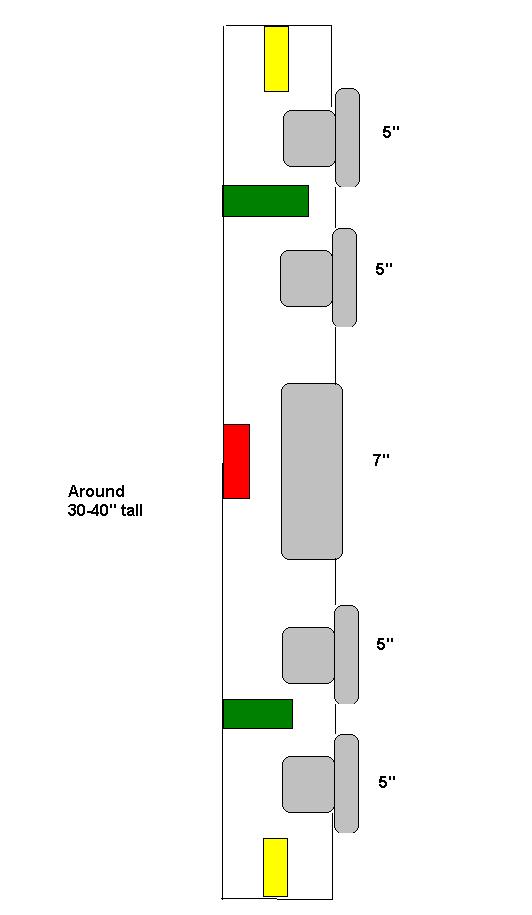
The caT
|
|
|
|
Posted by Lbjefferies7 on
09-15-2008
|
The least offensive result I have gotten from a ported speaker was closest to the yellow option. I built a pair of small monitors with ports on the top purely because it was the only way they would fit. I cannot reasonably explain why the result was better, but they had the least "ported" sound while still gaining the extension of the ported design. They integrated themselves into the room better than other speakers I have tried. The new speakers that I built just recently ("teardrop" MTM's, paper cones, silk HF, 1st order crossovers) I built with replaceable backs. The first ported backs just did not work out, so now I have them sealed.
I would beware of the Red option. Ports act as filters and as the diameter goes up, you are more likely to encounter noise from higher frequencies. With your 4" mid-woofers, one or two ports of 1.5-2 inches would probably be better.
If you go for the Green option, you might consider putting a 90 degree bend in them so that they point either upwards or downwards in the enclosure. This is in hopes to eliminate direct higher frequencies from the drivers.
Hope this helps.
Sincerely,
LBJ
|
|
|
|
Posted by Romy the Cat on
09-15-2008
|
|
Thanks, LBJ
It is useful. I had also an idea to have a port mounted on removable plate in order to have the port side changed. I also, very much inclined for the yellow version, even my reasons are very none objective and I based my superstitions on the fact that a few commercial ported speakers that I do not hate had ports under the bottom (like older version of Edddelons). Do you know what the depth of the port in the chassis responsible for?
I have a crazy ides but I do not know it I go for it. In yellow configuration I might have pipe with inner diameter of 1.25” welded from top port to bottom port. The pipe will be though the speaker, keeping the speaker sealed. The pipe will have spiral cuts. Inside this pipe I will have another pipe with outer diameter of 1.25” with similar spiral cuts. Now, turning on the coupling thread the inner pipe relative to the outer pipe I will have change the virtual port opening… I am sure it will do the venting effect but I have no idea how the geometry of the initial escape of pressure affect sound. It very much possible that the profile of the port exist’s not the port’s entry is important and if it is the case then my idea will work and let me to fine tune the port by ears.

The caT
|
|
|
|
Posted by Lbjefferies7 on
09-16-2008
|
|
That is certainly a new idea. Unless it is really easy to take it out and start over, I would not do it. I just have no idea whether or not it will work without making noise. I have always just used mathematical calculations for ported speakers, so anything I write here should be taken at face value. http://graph.flexunits.com:8080/index.htm may be a helpful calculator for you to play with.
If you had one pipe with an inner diameter at 1.25" and another pipe with an outer diameter of 1.25", you could cut off the ends at a 45 degree angle. The theoretical port length should be at the mid point of the angle. The inner pipe could then be turned to very finely tune the port. I hope this is clearer than it sounds. Check out the attachment. I think that this might be the best way to finely adjust the length of the port while minimizing the risk of unwanted noise.
Regards,
LBJ
|
|
|
|
Posted by Lbjefferies7 on
09-16-2008
|
|
This may help explain...
|
|
|
|
Posted by Romy the Cat on
09-16-2008
|
 Lbjefferies7 wrote: Lbjefferies7 wrote: | | I just have no idea whether or not it will work without making noise. |
|
That is exactly my point. I am sure that it will make noise anyhow, as any port does, but how masked out and how annoying that noise will be is completely out of realms of my ability to predict. I do presume that the port boom will be here anyhow (it will not be the proper bass) but the objectives are not to make a “good” speaker but to make acceptable speaker … I still would like the Macondo’s MiniMe to have at list the general tonal balance of Macondo – I heavily rely on some uniqueness of the bass drivers that I found but will see how it goes…
BTW, to minimize the footprint I think to do for a steel box, perhaps 2-3mm, or course damped from inside. Any comments regarding that?
The caT
|
|
|
|
Posted by Paul S on
09-16-2008
|
|
You might find it can sound better if each driver has its own box and its own port (PITA, I know). I have had better success by tuning the port +/- below audibility and then using some whimpy foam to partially block the "too large" opening, as opposed to making the inlet smaller.
Does it defeat your purposes (in terms of efficiency) to use minimal stuffing or an internal hanging "curtain" in any of the boxes? Obviously this gives the option for smaller boxes, albeit at the expense of some efficiency.
Basically, the more you try to do with/get from the port, the more of it you'll hear.
I've only tried steel with very small, sealed nearfield boxes, but it needs well-bonded, effective damping. I used acrylic-modified stone mortar and felt in my DEBZs, which are 1 1/4" plywood. The thing with steel is, it seems so "severe" and "unforgiving", certainly a great, grand, expensive PITA to build and to modify.
BTW, I agree that the math is a great place to start.
Best regards,
Paul S
|
|
|
|
Posted by haralanov on
09-17-2008
|
After I spend so much time in experiments with ports, I found some interestind aspects in port loading. Our primary objective is to eliminate the nasty air resonances in port at middle frequencies, which kill all the lower midrange sound. It is achieveable only if the bassreflex has very small area. The standart bassreflex loading is out of the game due to the port leakage at approximately 400-800Hz (depending of it’s surface). The key to eliminate these "alien" sounds is having a lot of very small ports with equal lenght and equal port area. This way the port resonances are pushed above the driver's bandwith and they don’t disturb the sound. To explain the concept in a simple way let imagine we have a port with lenght "x" and area "y", tuned to your desired frequency Fb. If we make 10 smaller ports with the same lenght "x" but with port area "y/10" the tuning frequency will remain the same, but the Sound will be very different. This way we can also lower the dynamic compression and place the port at different optimal positions on the enclosure surface. The best result I have ever achieved is when I used little “pillows” filled with sheep's wool inside the ports to restrict the air flow. This method achieves much better dynamics compared to sealed enclosures without the disturbing and self-accentuated port sound. Also there is no need of electrical filtration one octave above port's tuning frequency Fb with this kind of filling.
If somebody is going to use that method, it is very important you must NEVER tune the port BELOW driver resonance. Some people do it to extract some extra low bass from the system but they never get good sound. This is going to kill all the mid and upper bass of your drivers. Also if we want to achieve absolutely minimal dynamic compression it is highly recommendable the total port area is no less than driver’s cone area. If you implement this kind of bass loading properly, you can hardly get any sound of the ports openings, but the dynamics of the system will be doubled compared to closed box without loosing the good tonality of bass. The is another great advantage – you can change the tuning frequency (to better integrate the sound with your room) by simply block up the output of some of the ports...
I will try to visualize the idea. Constructing a series of little ports is very easy game, especially if one use MDF. IMHO, the best position of the ports is on bottom and the top of the speaker cabinet (sound wise):

The port should use the inner surface of the cabinet walls as an extension:
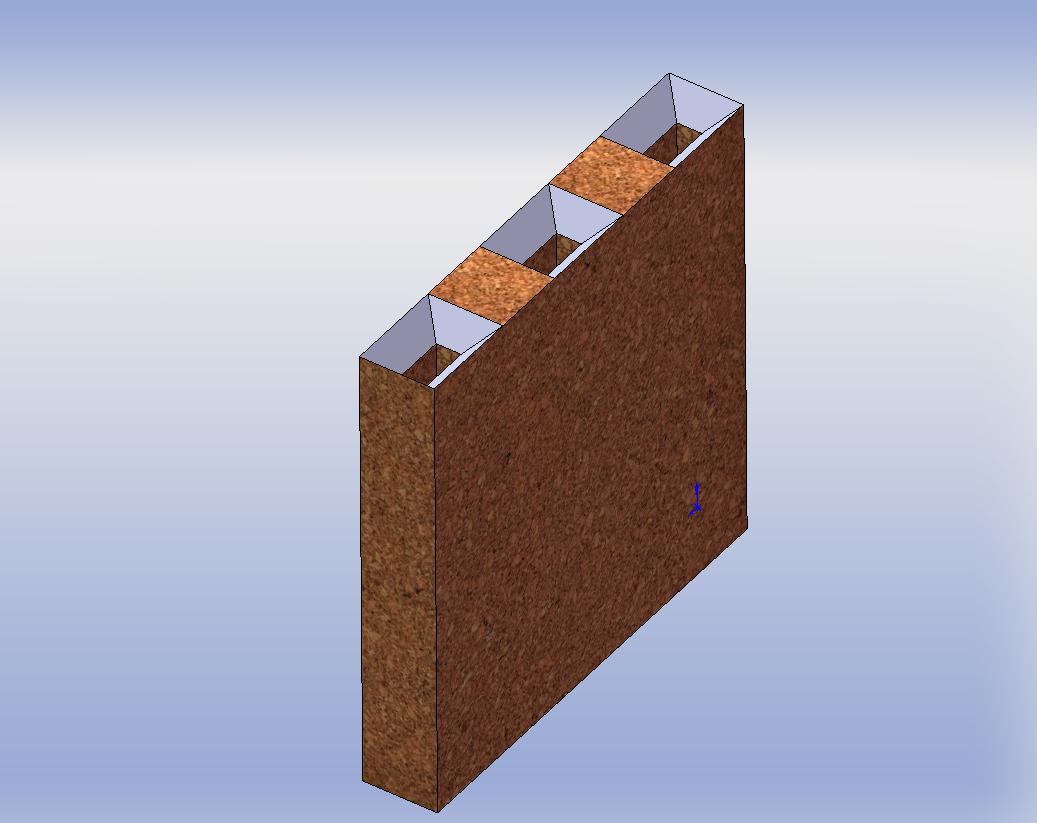
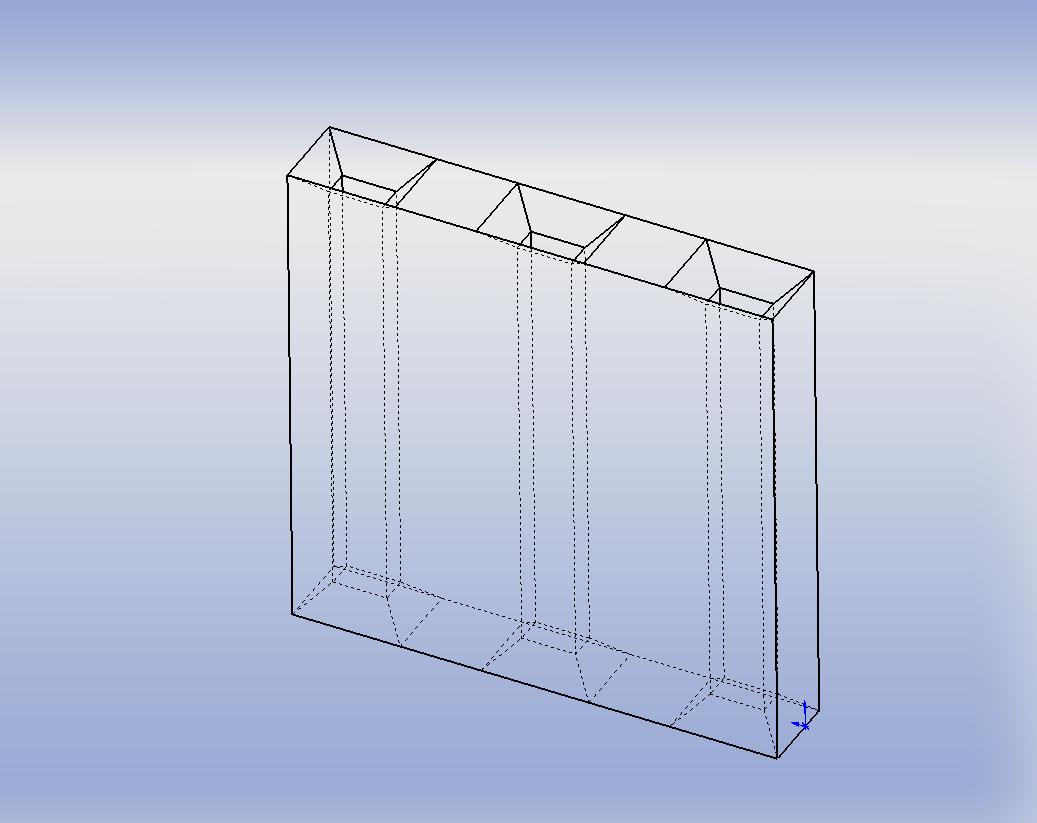
Rgs,
Petar
|
|
|
|
Posted by Romy the Cat on
09-17-2008
|
|
Petar,
What you say doe make sense but I think I am in a different environment. I use the driver about what I have no knowledge at all, I do not even know at this point where to source them. I will drive the thing lower then the drivers resonance frequency, if fact I will drive them as low as I can. I would agree that it ming and most probably will puff up bass and kill the lover MF. I will deal with it when I get there, but this Pilot speaker do not get objective to be a great speaker but rather “sufficient” speaker.
I like the idea of horn-like opening of the port –it shell create more smooth transformation of pressure. I was thinking about it myself as well as I have seen a few companies do it. Your idea of multiple small ports very much attracts me and I might very much go for it. I do not know how it effect sound by the fact of being multiple but to have 8 smaller ports on each side would allow to plug a few ports by ears if I found it necessary – sort of playing a flute on the ports (valves) and tune the speaker to what it shell be –very slick idea and very much affinity with my level of insanity. The multiple small ports would be much easier to implement then my idea of reviving pipes….
There is two subjects that I do not know. Could you or anybody ease, tell me the different (in behavior of sound) between those versions:
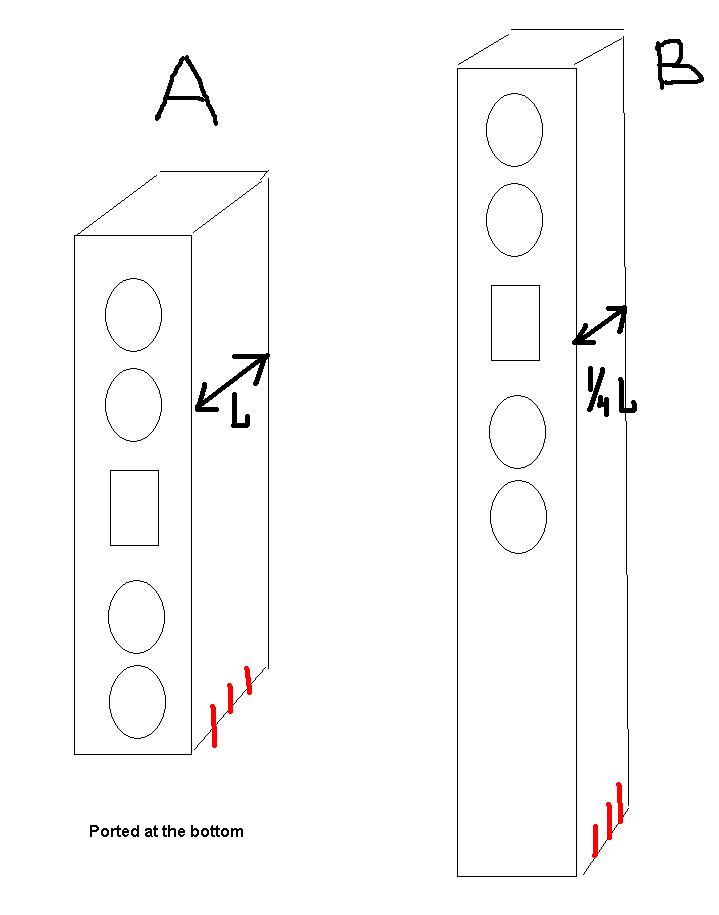
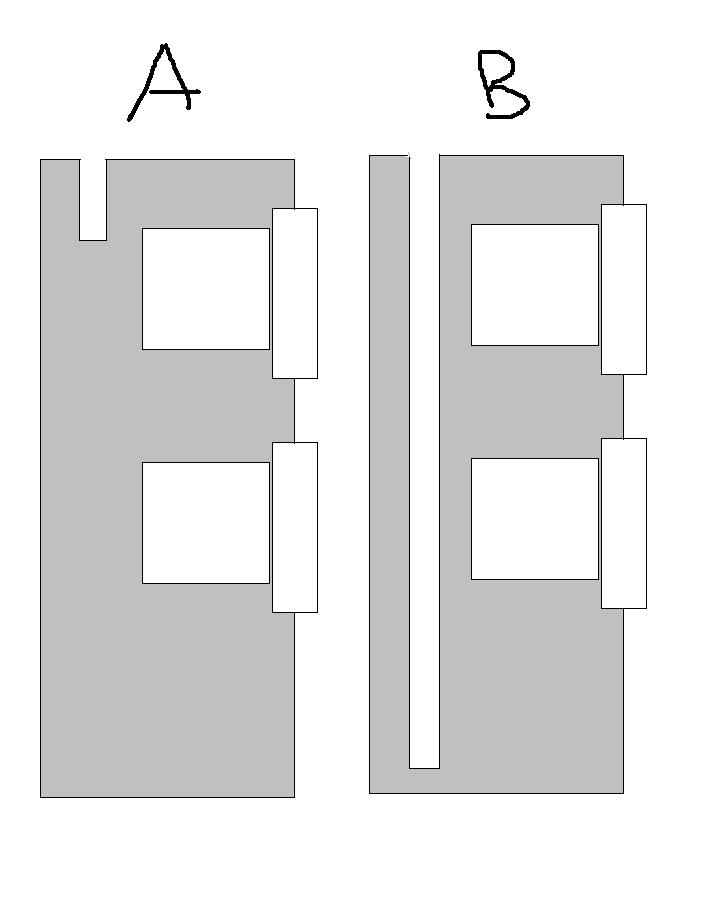
|
|
|
|
Posted by Paul S on
09-17-2008
|
It has been some time since I used BR above LF, but you pretty much summed up my experience in a much more articulate manner than I have been doing. I have tried a "default version" of the "many small ports" that used a perforated "mask" over a larger port, and I do not recommend this. Reading your explanation, I understand immediately why it did not work, because each of your several small ports is intentionally tuned higher, above, say, 800 Hz, and you clearly explained why.
Very smart. Just for fun, I think I will try putting some tight little "fingers" in my BR bins' 1 1/2" X 20" slots...
Maybe it will conquer the bad electricity...
Best regards,
Paul S
|
|